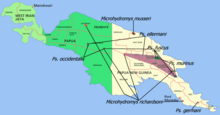New Guinea moss mice
| New Guinea moss mice | ||||||||||||
|---|---|---|---|---|---|---|---|---|---|---|---|---|
| Systematics | ||||||||||||
|
||||||||||||
| Scientific name | ||||||||||||
| Pseudohydromys | ||||||||||||
| Rümmler , 1934 |
The pseudohydromys ( Pseudohydromys ) are a rodent species from the group of murinae (Murinae). The genus includes twelve species, all of which are native to New Guinea .
These rodents reach a head body length of 7 to 12 centimeters, in addition there is a 9 to 10 centimeter long tail. The weight of these animals is 13 to 20 grams. Their fur is dark brown or dark gray on the top, the underside is lighter. The muzzle is elongated, the skull flat. The toes are connected by small, web-like membranes.
They are common in New Guinea. Their habitat are mountain forests up to 3600 meters above sea level. Despite the generic name, which suggests a similarity to the swimming rats ( Hydromys ), they do not show any adaptations to aquatic life, but are land dwellers. Their diet consists mainly of insects.
A distinction is made between 12 types (selection):
- The Shaw-Mayer mouse ( Pseudohydromys ellermani ) is the only rodent with only one molar per half of the jaw and thus the fewest teeth of all rodents. It used to be incorporated into the Mayermys genus .
- Pseudohydromys fuscus is common in eastern New Guinea. It was previously incorporated into the monotypic genus Neohydromys .
- Pseudohydromys germani was only described in 2005 and is only known from one location in the extreme south-east of New Guinea.
- Eastern moss mouse ( Pseudohydromys murinus ) lives in eastern New Guinea.
- Western moss mouse ( Pseudohydromys occidentalis ) is known from two populations in central New Guinea.
- Pseudohydromys musseri (Flannery, 1989) is only known from a single specimen that was found in northern New Guinea in 1972. This species has a brownish fur. For a long time, Pseudohydromys musseri was included in the genus Microhydromys, but was returned to the genus Pseudohydromys in 2009.
There is not enough data for P. germani , P. occidentalis and P. Musseri , the other three species are not endangered according to the IUCN .
The genus is systematically classified within the old world mice in the Xeromys group .
Individual evidence
- ↑ Kristofer M. Helgen & LE Helgen: Biodiversity and biogeography of the moss-mice of New Guinea: a taxonomic revision of Pseudohydromys. RS Voss & MD Carleton (eds.): Systematic Mammalogy: Contributions in Honor of Guy G. Musser . Bulletin of the American Museum of Natural History, 331, pp. 230-313, 2009
literature
- Ronald M. Nowak: Walker's Mammals of the World. 2 volumes. 6th edition. Johns Hopkins University Press, Baltimore MD et al. 1999, ISBN 0-8018-5789-9 .
- Don E. Wilson , DeeAnn M. Reeder (Eds.): Mammal Species of the World. A taxonomic and geographic Reference. 2 volumes. 3. Edition. Johns Hopkins University Press, Baltimore MD 2005, ISBN 0-8018-8221-4 .
Web links
- Pseudohydromys on the IUCN Red List of Threatened Species. Retrieved October 10, 2009.
